Abstract
Prolonged exposure to odour emissions causes annoyance which leads to nuisance and consequently to complaints. Different methodologies exist in the literature to evaluate odour impacts, but not all are suitable to assess environmental odour nuisance. Information about their applicability criteria and comparison, is scarce and referred to short time analysis. The research presents and discusses the application of different methods to characterize and assess odour nuisance around an industrial plant localized in a sensitive area. Experimental activities are carried out through a long-time analysis programme. Field inspections and predictive methods are investigated and compared. A modification of the traditional dispersion modelling approach is proposed in order to adapt its application for the prediction of the odour nuisance. The offensiveness and location factors are identified as key parameters in the quantification of the perceived nuisance. The integrated dispersion modelling multi-level approach is highlighted as the most suitable for defining the plant strategies. The paper provides useful information to characterize environmental odour problems and identify appropriate solutions for an effective management of odorous sources, with the aim of reducing complaints, restoring the proper relationship between odorous plants and the surrounding communities and increasing the overall quality of the environment.
1. Introduction
Odour emissions from industrial plants, especially those involved in environmental management (e.g., wastewater treatment plants, landfills, composting plants) are among the leading cause of odour annoyance within the population living in the surrounding areas. Odour annoyance does not directly affect the health but implies a contingent perception of risk [1,2,3] and consequently leads to complaints [4,5].
Annoyance is the complex of human reactions that occurs as a result of an exposure to an ambient stressor (odour) that causes negative cognitive appraisal once perceived [6,7]. A repeated annoyance event over an extended period of time that leads to modified or altered behaviour, causes nuisance [4,8]. The main effects on human health caused by continuous exposure to odours are irritant properties, as well as cardiovascular, respiratory and psychobiological effects [9,10,11]. Therefore, appropriate monitoring along with regulatory tools are necessary to prevent, control and mitigate the emissions of odours from industrial plants and their consequent nuisance in ambient air in an objective and repeatable manner [12,13,14]. The evaluation of the real nuisance is fundamental to identify the appropriate solutions to adopt to manage the odour problem without underestimating or providing wrong information [15,16].
In the current literature, there are few studies which deal with the identification of the odour nuisance in ambient air. Information about their applicability conditions and comparison between the different approaches, is scarce and referred only to short time-periods. Moreover, no investigation between the perceived odour nuisance and the odour sources and management is reported. Almost all of the studies present in the literature focus on the evaluation of the odour impact [4,5,17,18,19,20,21] and present comparisons between the different methodologies used [12,22,23,24]. However, the odour impact should not be confused with the odour nuisance and not all the methodologies applied to evaluate the odour impact are suitable to assess odour nuisance [25]. The likelihood of an odour to create nuisance is evaluated by using the FIDOL factors: frequency (F), intensity (I), duration (D), offensiveness (O), and location (L) [4,17,26]. According to this approach, the definition of odour concentration is not complete with a view of defining odour nuisance [27,28].
In order to evaluate the occurrence of odour nuisances in an area where there are odours and/or odour sources, the use of field methods that allow the participation of the communities (also known as Citizen Science methods [29]) would be particularly effective, but they are generally expensive and require a long application time [4]. At the current state, for the assessment of odour nuisances, the methods that use field inspections are carried out through two standardized approaches: using trained assessors (human panel) [30,31] and by means of questionnaires distributed to the local population [32]. These approaches rely on the determination of all the FIDOL factors. On the other hand, the most used approach to predict odour impact from a plant is based on the simulation of their odour emissions using atmospheric dispersion models [4,33,34]. This method is time-saving to deliver the results, but, generally is not useful for evaluating the community odour annoyance and nuisance, as it does not consider properly the factors offensiveness (O) and location (L) [25,35].
The offensiveness (O) factor of an odour can be assumed coincident with its hedonic tone [4]. In Europe, the German guideline VDI 3882/2 (1994) [36] describes one of the most widely used methods to determine the hedonic tone. While in the United Kingdom, different concentration thresholds are set, in relation to the types of industrial plants, so as to take into account the offensiveness parameter in the conventional dispersion model approach [37].
The location (L) factor can be represented by the sensitivity of the area where the odour is dispersed and perceived [4]. Recent studies propose taking into account the different territorial sensitivities to odours through the definition of a “Nuisance Action Plan” (NAP) in urban planning [28]. Indicators and criteria, such as the “land use destination or class of location” (L), “abundance of receptors” (R) and the existing “environmental pressures” (P) are suggested to elaborate the NAP. According to the definition of the location parameter, an area with a major sensitivity is less inclined to support an odour presence.
This paper presents and discusses the application of different methods to assess the odour nuisance perceived by the communities and caused by an industrial plant. The comparison of the methods is highlighted through an application to a real case study over the long time period of one full year. Field inspection methods through trained assessors (grid method) and with questionnaires as well as the predictive dispersion modelling approach are investigated. A multi-percentile and multi-odour concentration threshold criterion approach is proposed and explored in the paper to allow the application of the dispersion model for the prediction of the community odour nuisance. The study aims to provide relevant information and tools to develop effective control or warning strategies for the plant managers, the local control bodies and the annoyed population, in order to manage the odour nuisance problem in an effective manner, reducing the possibility of complaints and increasing the environmental air quality. Moreover, the results can be usefully applied in the design and testing of odor control technologies in odour nuisance problems.
2. Materials and Methods
2.1. Investigated Area
Research activities were carried out by considering the odour nuisance to the community linked to a Wastewater Treatment Plant (WWTP). The surrounding area in which the plant is located is characterized by the presence of a consistent number of sensitive receptors and citizens. A medical diagnostic centre (DC) and a large shopping centre (SC) are situated close to the plant. While slightly further away from the WWTP, there are various shops (SH), bathing beaches (BB) and residential buildings (RB) (Figure 1). A large number of people attend the area for work or leisure on a daily basis, in addition to those who permanently live there.
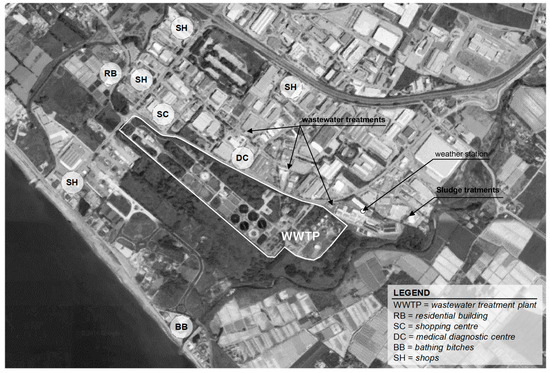
Figure 1.
Investigated area and WWTP with principal surrounding sensitive targets (Maps Data: Goggle, ©2019 CNES/Airbus, European Space Imaging, Maxar Technologies).
The investigated WWTP is a conventional activated sludge plant, designed for 700,000 PE (population equivalent). The plant treats civil wastewater from eleven municipalities with an hourly average flow rate of about 8000 m3/h. The layout of the plant highlights two parallel lines for the wastewater treatments and one single line for the sludge treatment.
2.2. Odour Nuisance Characterization by Trained Assessors
The field inspection technique by trained assessors was carried out according to the EN16841-1:2016 [30]. The grid method was applied covering an area of 2.625 km2 (1.750 × 1.500 km2), with the WWTP located in the central position. The selected area included the surroundings of the WWTP, where the odour receptors are prevalent, and it extended in the prevailing wind direction. A total of 42 cells were identified in the investigated area, dividing them into a square mesh of 250 m per side. Ten assessors, divided into teams of four persons, selected according to EN 13725:2003 and familiarized with the on-site specific wastewater odour quality category, identified as only one, were used in the field analysis. According to EN16 841-1:2016, for each corner point, the “odour hours” (nh) were calculated, along with the “odour load” (OL) for each mesh. For the study, one odour-hour was considered if, by sniffing 1 time every 10 s for an interval of 10 min, the investigated odour quality category was positive perceived for 6 or more times (10% of the defined measurement interval); while the odour load was calculated as the ratio between the sum of odor hours calculated for the 4 corner points, divided by the total number of inspections for the mesh. The weather condition was continuously detected during the surveys, using a weather station located inside the investigated plant (Figure 1) and a portable Kestrel 4000 Pocket Wind Meter (Nielsen-Kellerman, PA, USA) anemometer, in order to take into consideration, the effects of atmospheric dispersion of the substances emitted and perform the field inspection measurement in optimal conditions under wind (wind speed between 1 to 3 m/s, temperature below 35 °C), avoiding possible false positives [38]. A total of 104 single measurements for each assessment point were carried out, over the annual monitoring period, situated generally at a point of intersection of the grid lines. No points were selected within the plant fence line. In detail, two field inspections per week were carried out, according to the EN16841-1:2016 with a survey on the scale of 104 field inspections in a full year. No consecutive days were used for the measurements; throughout the annual period, all days of the week were given roughly equal priority (each day of the week was represented about four times for 104 measurement days); for each assessor during a measurement round, no more than 10 to 12 points were included; the scheduling of the daily start of inspection was elaborated in order to have, after 26 single measurements per measurement point, field inspection data for different times on the day, for all measurement points, thus allowing a statement representative of the course of the day.
The odor frequency in terms of “odour hours” (nh), assessed in the 42 assessment squares, was represented graphically through isofrequency odour maps, generated by means of the kriging interpolation geostatistical method, performed using the Surfer software [39]. Four isofrequency levels were performed in the study to analyse the odour nuisances: nh < 10%, no odour nuisance; 10% ≤ nh < 15%, odour nuisance for residential area; 15% ≤ nh < 25%, odour nuisance for industrial area; nh ≥ 25%, strong nuisance [40].
2.3. Odour Nuisance Characterization by Questionnaires Survey
The sociological survey implemented through questionnaires was prepared according to the German guidelines VDI 3883—Part 1 (2015) [32] in order to characterize the odour nuisance in the investigated area caused by the WWTP odour type. The elaborated survey form was a closed type, consisting of a series of multiple questions, structured so as to consider the FIDOL factors (frequency, intensity, duration, offensiveness and location) as well as to characterize the general information and personal data of the subjects interviewed. Even if the questionnaire was inspired by some existing guidelines, it did not correspond to any standard survey form, but was specifically tailored to refer to only the wastewater treatment odour quality. Each question included five possible responses.
Twenty different investigation points were selected in an area of about 3 km2 around the WWTP in which the questionnaires were submitted verbally to the respondents by an expert assessor.
The questionnaires were addressed specifically to residents and employees who have been working for many years in the survey area and who are able to describe what a WWTP does, in order to increase the reliability of the answers. The sample was randomly selected in the investigated area, trying to respect the demographic profile of the investigated zone [41].
A total of 1000 observations were recorded during the monitoring period of one year, 50 for each point. The choice of the distribution points was made in the prevailing wind direction and included the zone where the odour receptors were prevalent, around the WWTP. Different distances from the source were selected according to the Miedema study [27], for the individuation of the investigation points, ranging from as close to the plant as possible to a distance where the odour was expected to be hardly detectable [42,43]. Twelve investigated points were included at a distance of 500 m from the nearest border of the WWTP area.
The collected data were encoded in Excel and statistically processed. The odour annoyance index (OAI) was calculated for each investigated point, using the data referring to the questions related to the FIDOL factors [35,44] by applying the following equation:
where:
- -
- Py is the investigated point (y = 1–20);
- -
- Nt is the total number of recorded observations for the investigated point;
- -
- wi are the weighting factors of the answer i (i = 1–5) of the question n (n = 1–5);
- -
- Ni are the number of observations recorded at the answer i of the question n.
Five annoyance levels were defined in the study to analyse the odour nuisances: OAI = O, no odour nuisance; 0 < OAI ≤ 1.25, slight odour nuisance; 1.25 < OAI ≤ 2.50, distinct nuisance; 2.50 < OAI ≤ 3.75, strong nuisance; 3.75 < OAI ≤ 5.00, extreme nuisance.
2.4. Odour Nuisance Characterization by Atmospheric Dispersion Modelling
The Calpuff Modelling System was used to simulate the dispersion of the odours emitted by the WWTP in the atmosphere, in order to assess the odour impact due to the presence of the WWTP. The Calpuff Modelling System consists of three basic components: a meteorological preprocessor (Calmet) [45], the dispersion model (Calpuff) [46] and a graphical post-processor (Calpost). For the application, three different types of input data are provided: topographical, meteorological and emission.
A modelling domain of 16 km2 (4.0 km for each side) was selected, with a square grid of receptors every 100 m. Hourly average data of the meteorological parameters (e.g., wind direction, wind speed, atmospheric stability, temperature, precipitation, etc.) covering one year were given as input. These data were recorded by a meteorological station located in the WWTP area (Figure 1) and elaborated by the preprocessor Calmet.
Seven different odour sources (Pi, i = 1–7) (Figure 2) were investigated in terms of emission data, calculating their Odour Emission Rate (OER). Four of the investigated sources belong to the wastewater treatment lines, while three sampling points are related to the sludge treatment line. Eight samplings for each source were carried out, over a monitoring period of two months, with a weekly frequency. In total, 56 samples were collected. The OER values used in the simulations were calculated using the highest values of the Specific Odour Emission Rate (SOER) detected over the entire analysis period to simulate the worst case scenario. The SOER values were determined in relation to the source typology as a function of the measured odour concentration [4]. A vacuum sampler (Ecoma, D) equipped with a 10 L Nalophan bag and a SF450 flux chamber (Scentroid, IDES Canada Inc., Whitchurch-Stouffville, ON, Canda) was used for the sampling. The operating parameters of the flux chamber were: diameter 450 mm, an enclosed surface area of 0.155 m2 and neutral air flux equal to 3.9 lpm.
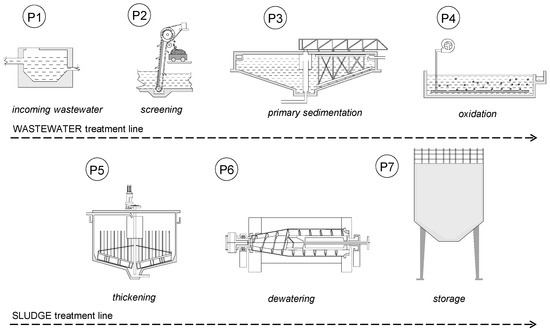
Figure 2.
Investigated odour sources (Pi, i = 1–7).
Odour concentrations of the collected samples were carried out by dynamic olfactometry analyses, conducted at the Olfactometric Laboratory of the Sanitary Environmental Engineering Division (SEED) of the University of Salerno, according to the EN 13725:2003. A TO8 olfactometer (ECOMA, D), based on the ‘‘yes/no’’ method, was used relying on a panel composed of four trained experts. All the measurements were analysed within 14 h after sampling, according to Zarra et al. [47].
A peak-to-mean ratio (P/M) equal to 2.3 was adopted, according to Italian guidelines [5,46,48], in order to obtain the hourly peak concentration as the output of the Calpuff dispersion model.
The simulation period was set equal to one year. The meteorological data used refer to the same year in which the field inspections were carried out.
In order to adapt the method to assess the odour nuisance, the offensiveness (O) and location (L) factors were implemented in the conventional dispersion modelling application approach. The offensiveness of the odour was considered by assuming that its influence is directly related to the use of a different odour threshold concentrations values adopted to calculate the results, according to the approach carried out by the UK Environmental Agency in the H4 guidance. The location factor was introduced by investigating its variability on the percentiles of calculation (equal to the hours of odour exposure), taking into consideration that an area with major sensitivity is less inclined to support an odour presence [4].
Hourly average odour concentrations thresholds (CT) values of 1.0 OUE/m3 and 1.5 OUE/m3 and the 85th and the 98th percentile (pT) were investigated; the values were selected according to those indicated by the German guidelines GOAA [40] and the UK Environmental Agency H4 guidance [37] for the odour impact evaluation. A total of four long-term simulations of one year duration were carried out.
3. Results and Discussions
3.1. Odour Nuisance Characterization by Trained Assessors
Figure 3 reports the three isofrequency levels of odour hours calculated over the overall monitoring period for the investigated area.
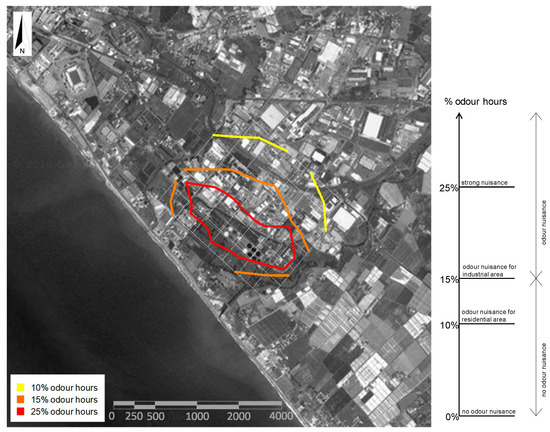
Figure 3.
Isofrequency levels of odour hours (Maps Data: Goggle, ©2019 CNES/Airbus, European Space Imaging, Maxar Technologies).
The results show that the area affected by a strong nuisance of the considered odour quality type (wastewater odour) is basically coincident with the area of the WWTP location (Figure 1). The form of the isofrequency level representing the strong nuisance odour provides an indication of the areas of the plant that contribute most to the odour nuisance and on which it is therefore necessary to act in order to reduce the olfactory nuisances for the neighbouring communities. For the investigated case study, the sludge treatments (Figure 2) (located on the almost extreme right of the area enclosed by the red line in the Figure 3) are highlighted as the sources that require greater attention in the management of odour emissions.
Considering the whole covered area by the grid method (equal to a surface of 1.5 km × 1.75 km = 2.625 km2), the study highlights furthermore how a surface of 1424 km2, corresponding to 54%, is annoyed if the area is considered as industrial, while a percentage of almost 93% is affected by odour nuisance if the area would be assumed as residential. In any case, only a very little area of the investigated surface was characterized by a percentage of odour hours less than the 10%. This result seems to indicate that the monitored area for the study is too small and that it would be advisable to extend this to have a greater overview. However, an extension of the area clearly involves more time and costs for the assessment.
Another result provided by this type of approach could be the identification of the minimum separation distance from the odour sources to be respected in order to not perceive the nuisance. For the analysed plant, a distance between 0.5 km and 1.10 km from the border of the location of the WWTP was identified.
3.2. Odour Nuisance Characterization by Questionnaires Survey
The personal data of the subjects interviewed, collected through the survey form, show that the gender distribution is almost equal (52% male—48% female), their age ranges mostly from 30 to 65 (59%) and from 18 to 29 (29%). Only 12% are in the range 66–72.
Of the 1000 total recorded individual observations, 226 questionnaires (22.6% of the total observations) report not having perceived odours of the wastewater treatment quality or not having perceived odours in the area. Figure 4 summarizes the results of the collected data of the persons that perceived WWTP odours, related to the part of the questionnaire which dealt with the frequency (F), duration (D) and offensiveness (O) of odours.
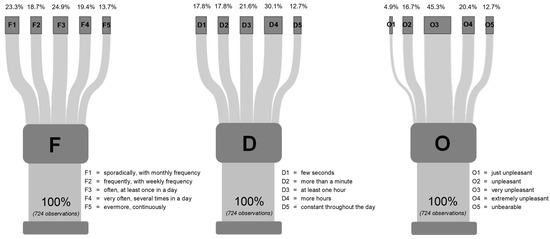
Figure 4.
Frequency (F), duration (D) and offensiveness (O) factors results of the questionnaires survey.
As reported in Figure 4, there is no significantly predominant frequency where the odour is perceived. However, the responses highlight a preponderance of lasting odour (more hours) and their “very unpleasant” hedonic tone (equal to 45.3% of the respondents).
Figure 5 shows the histogram of the distances, measured on the Google Earth map between the selected investigation points and the closest border point of the WWTP area, with reference to the number of observations. The distances are in the range of 40 m (point ID number XVII)–1550 m (point ID number I) (Figure 6).
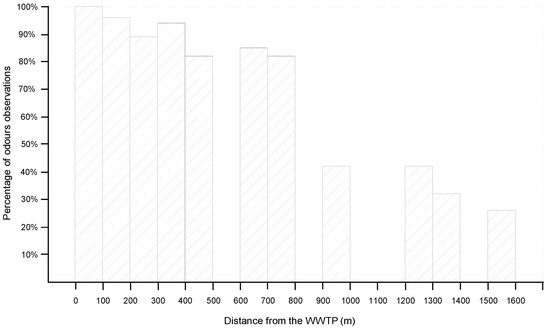
Figure 5.
Relation between the “odour” observations and the distances from the WWTP.
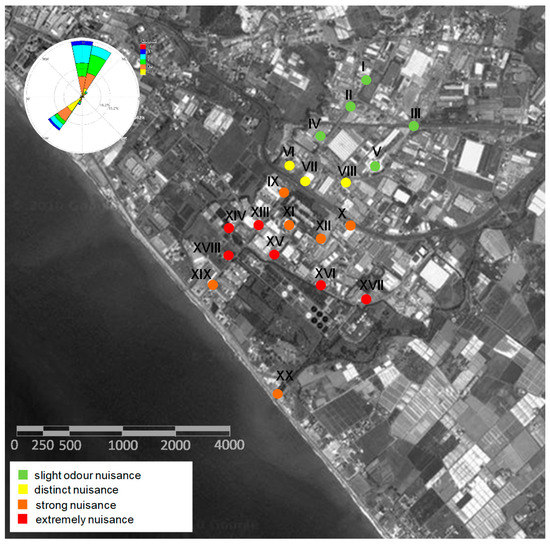
Figure 6.
Odour nuisance level for each investigated point complete with wind rose (Maps Data: Goggle, ©2019 CNES/Airbus, European Space Imaging, Maxar Technologies).
The results show that the odours emitted from the WWTP are perceived in their immediate surroundings. However, a decrease of the perception of the odour is detected upon increasing the distance from the plant. At distances greater than 800 m, there is a drastic drop in the number of interviewees who declare to have perceived WWTP odour.
Figure 6 shows the odour nuisance level assumed for each investigated point. The level was defined by calculating the Odour Annoyance Index (OAI) using all the collected data over the monitoring period.
The highest values of odour nuisance were recorded by individuals located closer the WWTP. The maximum OIA, equal to 4.51, was calculated for the medical diagnostic centre, identified with the investigation point number XVI in the field assessment survey. A strong nuisance was recorded up to maximum distances of 500 m from the WWTP fence line, where the bathing beaches (BB) and some residential buildings (RB) (investigation point identified with the number XX in the assessment scheme) are located.
The quantification of the OIA index allows to identify the real community odour nuisance perception at the investigated points and, consequently, provides helpful indications of the areas where the odour sources are located that require the definition of effective odour control strategies in order to decrease the nuisance. The main weaknesses of this type of approach are that it cannot be applied where people are not permanently present and that the representation of the results, in fact linked to the distribution of people, is fragmented. Another limitation of this technique concerns the application in areas with sufficient population density to achieve statistically significant results. However, its major strength should be represented by the direct involvement of the community.
3.3. Odour Nuisance Characterization by Atmospheric Dispersion Modelling
Figure 7 highlights, for each investigated source, the odour concentrations and the odour emissions values detected over the monitored period and used as input in the dispersion model.
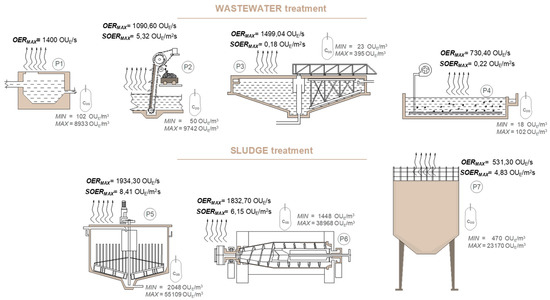
Figure 7.
Odour characterization data of the investigated sources of the WWTP.
In terms of odour concentration, the highest values were detected at the sludge thickening (55′109 OUE/m3) while the lowest in the oxidation unit (18 OUE/m3). Similarly, by analysing the odour emission rate data (OER), on the basis of the values of maximum specific odour emission rate (SOERmax (i = 1–8)) calculated over the whole analysis period, the treatment of thickening of the sludge highlights the maximum value (1′934.3 OUE/s).
Considering equal to 100% the value of the sum of the calculated odour emissions of the investigated sources, in terms of OER, the analysis shows how the treatment of thickening contributes with 21.45% to the total amount of emissions. Likewise, considering only the emissions from the investigated treatment processes of the WWTP, it is worth noting how the sludge treatments (P5, P6) represent 53.15% of the total odour emissions, while the wastewater treatments (P2, P3, P4) contribute with 46.85%.
The detected data also allow to highlight how the odour emissions related to a sludge treatment unit (on average equal to 26.58% of the total contribution, for treatment) is about 70% higher than those produced by a wastewater treatment unit (on average equal to 15.62% of the total odour emissions).
Figure 8 shows the results of the atmospheric dispersion model application. The isopleths relevant to the 98th and 85th percentile of the hourly peak concentrations of an odour threshold of 1.0 OUE/m3 and 1.5 OUE/m3 are represented in the maps. The combination of generally suggested values for example on the Guideline on Odour in Ambient Air (GOAA) in Germany (1 OUE/m3 and 85th) and on the EA in the UK (1.5 OUE/m3 and 98th) [5] is presented and elaborated in order to analyse their influence on the variation of the isopleths in terms of shape and impacted area.
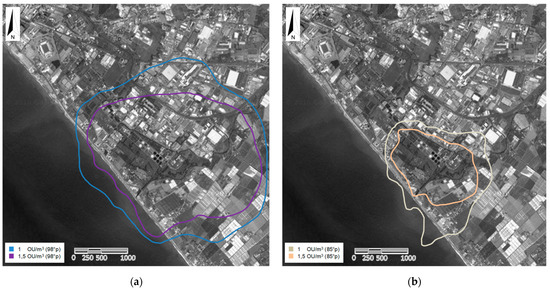
Figure 8.
Isopleths relevant to the 98th (a) and 85th (b) percentile of the hourly peak concentrations of an odour threshold of 1.0 OUE/m3 and 1.5 OUE/m3 (Maps Data: Goggle, ©2019 CNES/Airbus, European Space Imaging, Maxar Technologies).
The results show relevant differences of the calculated isopleths, especially in terms of the covered surface. The greatest odour annoyed area is obtained using an odour concentration threshold equal to 1.0 OUE/m3 and the 98th percentile. In this case, the isopleths cover an area of 8747 km2. While the smallest odour annoyed area (equal to 1533 km2) is identified by applying an hourly average odour concentration threshold of 1.5 OUE/m3 at the 85th percentile (i.e., that exceeds 15% of the hours in a year).
The isopleths relevant to a higher percentile (98th percentile instead the 85th percentile), as well as the use of a lower odour concentration threshold (1.0 OUE/m3 instead of 1.5 OUE/m3) confirm to be a more conservative approach, in accordance with other studies [5,49] in terms of odour nuisance identification, covering generally a larger area. In the identification of the odour annoyed area by the atmospheric dispersion model application, it is possible to note that it has a greater influence on the variation of the considered percentile compared to the variation of the hourly peak concentrations of the odour threshold. At the same time, it can be seen how the prevailing meteoclimatic conditions monitored in the area (see wind rose in Figure 6) produce a greater impact on the shape of the isopleths, adopting a lower percentile for their calculation.
3.4. Odour Nuisance Levels Comparison
Figure 9 reports the overlay mapping of the odour nuisance levels elaborated through the conventional field inspections methods as well as the results obtained by the integrated odour dispersion modelling approach, in order to consider the offensiveness (O) and location (L) factors, over the annual monitoring period. The calculated isopleths relevant to the 98th and 85th percentile of the hourly peak odour concentration thresholds of 1.0 OUE/m3 and 1.5 OUE/m3 are compared, respectively, with the odour nuisance levels defined by the application of the investigated field inspection methods.
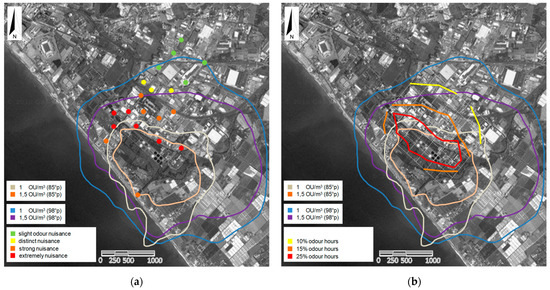
Figure 9.
Comparison of the odour nuisance levels calculated by adopting different approaches: (a) atmospheric dispersion modelling vs. field inspection method using the questionnaire-based survey; (b) atmospheric dispersion modelling vs. field inspection method using the survey based on trained assessors (Maps Data: Goggle, ©2019 CNES/Airbus, European Space Imaging, Maxar Technologies).
The different approaches define the odour nuisances in the investigated area; however, they offer different accessory information. The forecast modelling approach provides information of large surfaces and identifies the odour nuisances with a continuous “contour line”. The field approaches give information about the presence or absence of people in the area and the location of the sensitive receptors.
Although the dispersion modelling approach is less time-consuming, its results are strictly linked to the choice of the odour concentration threshold (CT) and its exceedance probability (pT). For the analysed case, large discrepancies are highlighted between the modelling and the field inspection approaches. The use of the 98th percentile and an odour concentration threshold of 1.5 OUE/m3 for the computation of the isopleths matches best with the field inspection method using the questionnaire-based survey. While the criterion with a lower exceedance probability (pT = 85%) underestimates clearly the odour hours in the north-west direction of the WWTP and, on the contrary, overestimates the frequency of odour hours in the south-east direction. Analogously, the use of the impact criterion with an odour concentration threshold of 1.0 OUE/m3 and the use of the 98th percentile overestimates the annoyed area by the WWTP quality odour, detected by the field inspection technique using the questionnaire-based survey, covering a wider surface everywhere around the plant.
The results of applying the 98th percentile and an odour concentration threshold of 1.5 OUE/m3 also allows to highlight the following interesting considerations. For the investigated WWTP, the nuisance in the surrounding area is caused by an overrun of a moderate odour concentration threshold (1.5 OUE/m3) for a few hours in the year (98th equals to about 175 h of one year with 365 days). The results, therefore, demonstrate the influence of the “location” factor in the identification of the nuisance area. The presence of a different type and number of receptors (such as the medical diagnostic centre and the large shopping centre) close to the WWTP area, its proximity to the residential centre and the large number of people who frequent the area for work or leisure on a daily basis, in addition to those who live permanently, are all factors that make the area particularly sensitive, for which a few episodes of overcoming are enough to create nuisance.
Furthermore, the outcome confirms the criteria reported in the “IPPC-H4” Guidance for Odour elaborated by the UK-Environmental Agency (2011) and proves that the odour emitted from a WWTP is very unpleasant (offensiveness characteristics), since a low odour concentration threshold is enough to cause annoyance. However, the results show also how the offensiveness of the WWTP odour, in the investigated case, does not assume the highest value (corresponding to an odour concentration threshold value of 1 OUE/m3, which defines in general the maximum protection level and/or the minimum separation distances for the receptors from the odour source). This may be related to the different odour sources present in the WWTP, attributing the odour nuisance above all to the odour sources of the sludge treatments, characterized by higher odour emissions in terms of OUE/m3.
The implementation of the offensiveness (O) and location (L) factors in the dispersion modelling approach is therefore a key action in order to generate results comparable with those of the field inspections and, consequently, for the evaluation of the nuisance.
The need to move from the approach which uses a default single-percentile and single-odour concentration threshold to a multi-criteria evaluation procedure, which takes into account the offensiveness and location factors to define the odour nuisance area, is therefore highlighted.
The choice of a multi-percentile approach leads also to solving other limitations related by the application of the traditional methodology, such as the restriction of the meteorological conditions that can be modelled [25]. Moreover, the appropriateness of a multi-criteria investigation proves that odour nuisance is not related to a univocal relationship between the intensity and the duration of the event. In fact, as observed by Cavalini [50], the nuisance for the inhabitants exposed to permanent weak odours are the same as the nuisance perceived to the exposure of discontinuous episodes of strong odours.
4. Conclusions
The application and comparison of different odour assessment approaches for the odour nuisance characterization in an urbanized area highlight the offensiveness and location factors as key factors in the analysis, especially in the dispersion modelling use.
For the atmospheric dispersion modelling approach, the application of a multi-percentile (pT) scale, correlated to the sensitivity of the area in which the odour is dispersed, proves necessary to consider the influence of the location (L) factor in the nuisance evaluation. The adoption of different odour concentration thresholds (CT), chosen on the basis of the hedonic tone of the investigated odour, turns out to be effective in implementing the factor offensiveness (O). A multi-criteria procedure, instead of one with predefined and pre-regulated criteria and relative values (percentile and odour concentration threshold) in any scenarios, that may overestimate or underestimate odour nuisance, is therefore to use to assess the odour nuisance. Furthermore, the adoption of a multi-criteria procedure will allow the introduction of an odour risk-assessment approach, supporting the definition of required protection level and/or minimum separation distances between the odour source and the nearest receptors [51,52,53,54].
On the other hand, for the field assessment techniques, the research shows a good correspondence between the assessed odour nuisance levels for the investigated methods. The field inspection with questionnaires provides results of an area in relation to the people availability and the collected data. The method can be affected by the emotional involvement in the problem of the interviewed persons. An extensive social participation and strong community involvement is therefore proven necessary in order to have objective evaluations.
The field inspection approach through trained assessors appears to be the most realistic approach to assess the odour nuisance. However, the method is expensive in terms of costs and human resources and requires long implementation times. An optimization of these factors can be implemented by analysing trends, according to the studies of Zarra et al. [38].
An ideal arrangement to assess the odour nuisances could be the use of the air dispersion modelling approach, determining the offensiveness (O) and location (L) factors to be implemented through questionnaires and validating the effectiveness of the results with the use of a restricted (in time and on measurement points) field inspection assessment through trained assessors.
The research provides useful information for the selection of the most appropriate odour nuisance assessment approach in urbanized areas, as well as to promote the development of integrated methods, in order to emphasize the strengths of each methodology, as well as optimize the overall reliability.
Author Contributions
Conceptualization, methodology, validation, formal analysis, investigation, T.Z.; writing, T.Z. and V.N.; resources, T.Z. and V.B.; supervision, T.Z., V.N. and V.B. All authors have read and agreed to the published version of the manuscript.
Funding
This research received no external funding.
Institutional Review Board Statement
Not applicable.
Informed Consent Statement
Not applicable.
Acknowledgments
The University of Salerno, the SEED Laboratory and SPONGE srl are acknowledged for the administrative and technical support.
Conflicts of Interest
The authors declare no conflict of interest.
References
- Aatamila, M.; Verkasalo, P.K.; Korhonen, M.J.; Suominen, A.L.; Hirvonen, M.; Viluksela, M.K.; Nevalainen, A. Odour annoyance and physical symptoms among residents living near waste treatment centres. Environ. Res. 2011, 111, 164–170. [Google Scholar] [CrossRef] [PubMed]
- Zarra, T.; Reiser, M.; Naddeo, V.; Belgiorno, V.; Kranert, M. Odour emissions characterization from wastewater treatment plants by different measurement methods. Chem. Eng. Trans. 2014, 40, 37–42. [Google Scholar]
- Oliva, G.; Zarra, T.; Pittoni, G.; Senatore, V.; Galang, M.G.; Castellani, M.; Belgiorno, V.; Naddeo, V. Next-generation of instrumental odour monitoring system (IOMS) for the gaseous emissions control in complex industrial plants. Chemosphere 2021, 271, 129768. [Google Scholar] [CrossRef]
- Belgiorno, V.; Naddeo, V.; Zarra, T. Odour Impact Assessment Handbook; John Wiley & Sons, Inc.: New York, NY, USA, 2012; pp. 1–312. ISBN 9781119969280. [Google Scholar]
- Brancher, M.; Griffiths, K.D.; Franco, D.; Lisboa, H.M. A review of odour impact criteria in selected countries around the world. Chemosphere 2017, 168, 1531–1570. [Google Scholar] [CrossRef]
- Naddeo, V.; Belgiorno, V.; Zarra, T. Odour Characterization and Exposure Effects; John Wiley & Sons, Inc.: New York, NY, USA, 2012. [Google Scholar] [CrossRef]
- Zarra, T.; Giuliani, S.; Naddeo, V.; Belgiorno, V. Control of odour emission in wastewater treatment plants by direct and undirected measurement of odour emission capacity. Water Sci. Technol. 2012, 66, 1627–1633. [Google Scholar] [CrossRef]
- Van Harreveld, A.P. From odorant formation to odour nuisance: New definition for discussing a complex process. Water Sci. Technol. 2001, 44, 9–15. [Google Scholar] [CrossRef] [PubMed]
- Claeson, A.S.; Lidén, E.; Nordin, M.; Nordin, S. The role of perceived pollution and health risk perception in annoyance and health symptoms: A population-based study of odorous air pollution. Int. Arch. Occup. Environ. Health 2013, 86, 367–374. [Google Scholar] [CrossRef] [PubMed]
- Jacquemin, B.; Sunyer, J.; Forsberg, B.; Götschi, T.; Bayer-Oglesby, L.; Ackermann-Liebrich, U.; De Marco, R.; Heinrich, J.; Jarvis, D.; Torén, K.; et al. Annoyance due to air pollution in Europe. Int. J. Epidemiol. 2007, 36, 809–820. [Google Scholar] [CrossRef] [PubMed]
- Schiffman, S.S.; Graham, B.G.; Williams, C.M. Journal of the Air & Waste Management Association Dispersion Modeling to Compare Alternative Technologies for Odor Remediation at Swine Facilities Modeling to Compare Alternative Technologies for Odor Remediation at Swine Facilities Dispersion Modeling to Compare Alternative Technologies for Odor Remediation at Swine Facilities. J. Air Waste Manage. Assoc. 2012, 58, 1166–1176. [Google Scholar]
- Ranzato, L.; Barausse, A.; Mantovani, A.; Pittarello, A.; Benzo, M.; Palmeri, L. A comparison of methods for the assessment of odor impacts on air quality: Field inspection (VDI 3940) and the air dispersion model CALPUFF. Atmos. Environ. 2012, 61, 570–579. [Google Scholar] [CrossRef]
- Wojnarowska, M.; Ilba, M.; Szakiel, J.; Turek, P.; Soltysik, M. Identifying the location of odour nuisance emitters using spatial GIS analyses. Chemosphere 2021, 263, 128252. [Google Scholar] [CrossRef]
- Zarra, T.; Galang, M.G.; Ballesteros, F.; Naddeo, V.; Belgiorno, V. Environmental odour management by artificial neural network—A review. Environ. Int. 2019, 133, 105189. [Google Scholar] [CrossRef] [PubMed]
- Muñoz, R.; Sivret, E.C.; Parcsi, G.; Lebrero, R.; Wang, X.; Suffet, I.H.; Stuetz, R.M. Monitoring techniques for odour abatement assessment. Water Res. 2010, 44, 5129–5149. [Google Scholar] [CrossRef] [PubMed]
- Giuliani, S.; Zarra, T.; Nicolas, J.; Naddeo, V.; Belgiorno, V.; Romain, A.C. An alternative approach of the E-Nose Training Phase in odour Impact Assessment. Chem. Eng. Trans. 2012, 30, 139–144. [Google Scholar]
- Nicell, J.A. Assessment and regulation of odour impacts. Atmos. Environ. 2009, 43, 196–206. [Google Scholar] [CrossRef]
- Sommer-Quabach, E.; Piringer, M.; Petz, E.; Schauberger, G. Comparability of separation distances between odour sources and residential areas determined by various national odour impact criteria. Atmos. Environ. 2014, 95, 20–28. [Google Scholar] [CrossRef]
- Badach, J.; Kolasińsk, P.; Paciorek, M.; Wojnowski, W.; Dymerski, T.; Gębicki, J.; Dymnicka, M.; Namieśnik, J. A case study of odour nuisance evaluation in the context of integrated urban planning. J. Environ. Manag. 2018, 213, 417–424. [Google Scholar] [CrossRef]
- Ravina, M.; Bruzzese, S.; Panepinto, D.; Zanetti, M. Analysis of Separation Distances under Varying Odour Emission Rates and Meteorology: A WWTP Case Study. Atmosphere 2020, 11, 962. [Google Scholar] [CrossRef]
- Zhang, Y.; Ning, X.; Li, Y.; Wang, J.; Cui, H.; Meng, J.; Teng, C.; Wanga, G.; Shang, X. Impact assessment of odor nuisance, health risk and variation originating from the landfill surface. Waste Manag. 2021, 126, 771–780. [Google Scholar] [CrossRef]
- Sironi, S.; Capelli, L.; Céntola, P.; Del Rosso, R.; Pierucci, S. Odour impact assessment by means of dynamic olfactometry, dispersion modelling and social participation. Atmos. Environ. 2010, 44, 354–360. [Google Scholar] [CrossRef]
- Capelli, L.; Sironi, S.; Del Rosso, R.; Guillot, J.M. Measuring odours in the environment vs. dispersion modelling: A review. Atmos. Environ. 2013, 79, 731–743. [Google Scholar] [CrossRef]
- Oettl, D.; Kropsch, M.; Mandl, M. Odour assessment in the vicinity of a pig-fatting farm using field inspections (EN 16841-1) and dispersion modelling. Atmos. Environ. 2018, 181, 54–60. [Google Scholar] [CrossRef]
- Griffiths, K.D. Disentangling the frequency and intensity dimensions of nuisance odour, and implications for jurisdictional odour impact criteria. Atmos. Environ. 2014, 90, 125–132. [Google Scholar] [CrossRef]
- Freeman, T.; Cudmore, R. Review of Odour Management in New Zealand. Air Qual. Tech. Rep. 2002, 24, 1–163. [Google Scholar]
- Miedema, H.M.E.; Walpot, J.I.; Vos, H.; Steunenberg, C.F. Exposure-annoyance relationships for odour from industrial sources. Atmos. Environ. 2000, 34, 2927–2936. [Google Scholar] [CrossRef]
- Fasolino, I.; Grimaldi, M.; Zarra, T.; Naddeo, V. Odour control strategies for a sustainable nuisances action plan. Glob. Nest J. 2016, 18, 734–741. [Google Scholar]
- Arias, R.; Capelli, L.; Diaz, C. A New Methodology Based on Citizen Science to Improve Environmental Odour Management. Chem. Eng. Trans. 2018, 68, 7–12. [Google Scholar]
- EN 16481-1. Ambient Air-Determination of Odour in Ambient Air by Using Field Inspection-Part 1: Grid Method; CEN: Brussels, Belgium, 2016. [Google Scholar]
- EN 16481-2. Ambient Air-Determination of Odour in Ambient Air by Using Field Inspection-Part 2: Plume Method; CEN: Brussels, Belgium, 2016. [Google Scholar]
- VDI 3883-1. Effects and Assessment of Odours—Assessment of Odour Annoyance—Questionnaires; Beuth Verlag GmbH: Berlin, Germany, 2015. [Google Scholar]
- Chemel, C.; Riesenmey, C.; Batton-Hubert, M.; Vaillant, H. Odour-impact assessment around a landfill site from weather-type classification, complaint inventory and numerical simulation. J. Environ. Manag. 2012, 93, 85–94. [Google Scholar] [CrossRef] [PubMed]
- Hayes, J.E.; Stevenson, R.J.; Stuetz, R.M. The impact of malodour on communities: A review of assessment techniques. Sci. Total Environ. 2014, 500–501, 395–407. [Google Scholar] [CrossRef] [PubMed]
- Nicolas, J.; Cors, M.; Romain, A.C.; Delva, J. Identification of odour sources in an industrial park from resident diaries statistics. Atmos. Environ. 2010, 44, 1623–1631. [Google Scholar] [CrossRef]
- VDI 3882-2. Olfactometry—Determination of Hedonic Odour Tone; Beuth Verlag GmbH: Berlin, Germany, 1994. [Google Scholar]
- Environment Agency. H4 Odour Management—How to Comply with Your Environmental Permit; European Environment Agency (EEA): Copenhagen, Denmark, 2011; p. 46. Available online: https://assets.publishing.service.gov.uk/government/uploads/system/uploads/attachment_data/file/296737/geho0411btqm-e-e.pdf (accessed on 27 May 2021).
- Zarra, T.; Naddeo, V.; Giuliani, S.; Belgiorno, V. Optimization of field inspection method for odour impact assessment. Chem. Eng. Trans. 2010, 23, 93–98. [Google Scholar]
- Golden Software Surfer 12. User ’s Guide; Golden Software, Inc.: Golden, CO, USA, 2014; pp. 1–124. Available online: http://downloads.goldensoftware.com/guides/Surfer12_Users_Guide_Preview.pdf (accessed on 27 May 2021).
- Administrative regulation. Detection and Assessment of Odour in Ambient Air—Guideline on Odour in Ambient Air GOAA (1994/1999/2004/2008). Länderausschuss Immiss. GOAA 2008. Available online: https://www.lanuv.nrw.de/fileadmin/lanuv/luft/gerueche/pdf/GOAA10Sept08.pdf (accessed on 27 May 2021).
- Sucker, K.; Both, R.; Bischov, M.; Guski, R.; Winneke, G. Odor frequency and odor annoyance. Part I: Assessment of frequency, intensity and hedonic tone of environmental odors in the Weld. Int. Arch. Occup. Env. Health 2008, 81, 671–682. [Google Scholar] [CrossRef]
- Piringer, M.; Schauberger, G. Dipsersion Modelling for Odour Exposure Assessment. In Odour Impact Assessment Handbook; Sons, J.W., Ed.; Wiley: Hoboken, NJ, USA, 2012; pp. 125–174. ISBN 9780813801261. [Google Scholar]
- Nicolas, J.; Delva, J.; Cobut, P.; Romain, A.C. Development and validating procedure of a formula to calculate a minimum separation distance from piggeries and poultry facilities to sensitive receptors. Atmos. Environ. 2008, 42, 7087–7095. [Google Scholar] [CrossRef]
- VDI 3883-2. Effects and Assessment of Odours—Determination of Annoyance Parameters by Questioning—Repeated Brief Questioning of Neighbour Panellists; Beuth Verlag GmbH: Berlin, Germany, 1993. [Google Scholar]
- Scire, J.S.; Robe, F.R.; Fernau, M.E.; Yamartino, R.J. A User’s Guide for the CALMET Meteorological Model; Earth Tech. Inc.: Concord, MA, USA, 2000; p. 37. [Google Scholar]
- Scire, J.S.; Strimaitis, D.G.; Yamartino, R.J. A User’s Guide for the CALPUFF Dispersion Model; Earth Tech. Inc.: Concord, MA, USA, 2000; p. 521. [Google Scholar]
- Zarra, T.; Reiser, M.; Naddeo, V.; Belgiorno, V.; Kranert, M. A comparative and critical evaluation of different sampling materials in the measurement of odour concentration by dynamic olfactometry. Chem. Eng. Trans. 2012, 30, 307–312. [Google Scholar]
- Schauberger, G.; Piringer, M.; Petz, E. Diurnal and annual variation of the sensation distance of odour emitted by livestock buildings calculated by the Austrian odour dispersion model (AODM). Atmos. Environ. 2000, 34, 4839–4851. [Google Scholar] [CrossRef]
- Brancher, M.; Piringer, M.; Grauer, A.F.; Schauberger, G. Do odour impact criteria of different jurisdictions ensure analogous separation distances for an equivalent level of protection? J. Environ. Manag. 2019, 240, 394–403. [Google Scholar] [CrossRef] [PubMed]
- Cavalini, P.M.; Koeter-Kemmerling, L.G.; Pulles, M.P.J. Coping with odour annoyance and odour concentrations: Three field studies. J. Environ. Psychol. 1991, 11, 123–142. [Google Scholar] [CrossRef]
- Schauberger, G.; Piringer, M.; Jovanovic, O.; Petz, E. A new empirical model to calculate separation distances between livestock buildings and residential areas applied to the Austrian guideline to avoid odour nuisance. Atmos. Environ. 2012, 47, 341–347. [Google Scholar] [CrossRef]
- Piringer, M.; Knauder, W.; Petz, E.; Schauberger, G. A comparison of separation distances against odour annoyance calculated with two models. Atmos. Environ. 2015, 116, 22–35. [Google Scholar] [CrossRef]
- Piringer, M.; Knauder, W.; Petz, E.; Schauberger, G. Factors influencing separation distances against odour annoyance calculated by Gaussian and Lagrangian dispersion models. Atmos. Environ. 2016, 140, 69–83. [Google Scholar] [CrossRef]
- Brancher, M.; Piringer, M.; Knauder, W.; Wu, C.; Griffiths, K.D.; Schauberger, G. Are Empirical Equations an Appropriate Tool to Assess Separation Distances to Avoid Odour Annoyance? Atmosphere 2020, 11, 678. [Google Scholar] [CrossRef]
Publisher’s Note: MDPI stays neutral with regard to jurisdictional claims in published maps and institutional affiliations. |
© 2021 by the authors. Licensee MDPI, Basel, Switzerland. This article is an open access article distributed under the terms and conditions of the Creative Commons Attribution (CC BY) license (https://creativecommons.org/licenses/by/4.0/).